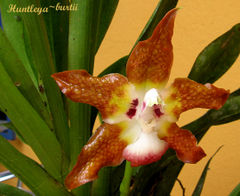Huntleya
| Huntleya subsp. var. | ||||||||||||||||||||||||||||||||||||||||||||||||||||||||
|---|---|---|---|---|---|---|---|---|---|---|---|---|---|---|---|---|---|---|---|---|---|---|---|---|---|---|---|---|---|---|---|---|---|---|---|---|---|---|---|---|---|---|---|---|---|---|---|---|---|---|---|---|---|---|---|---|

|
|
| ||||||||||||||||||||||||||||||||||||||||||||||||||||||
| ||||||||||||||||||||||||||||||||||||||||||||||||||||||||
Huntleya is a small orchid genus that includes fourteen species
These are epiphytic, pseudobulbless and often larger plants with subplicates leaves nearing forty centimeters long, erect and single-flowered. They occur in wet cloud forests at medium altitudes of Guatemala, Costa Rica, South America down to Bolivia. The type species Huntleya meleagris equally occurs in Trinidad.
| Standard Cyclopedia of Horticulture |
|---|
|
Huntleya (personal name). Orchidaceae. Epiphytal orchids without pseudobulbs, like Zygopetalum. Leaves several: fls. solitary on long peduncles in the If .-axils; sepals and petals similar, spreading, the lateral sepals forming a slight chin; lip articulated to the foot of the column, the upper part ovate, concave, narrowed into a broad claw below with a fringed callus; column broadly winged at apex; pollinia 4, upon an ovate stalk.—Species 2, in Trop. Amer.
|
Describe the plant here...
Cultivation
Propagation
Pests and diseases
Species
- Huntleya apiculata (Rchb.f.) Rolfe
- Huntleya brevis Schltr.
- Huntleya burtii (Endres & Rchb.f.) Rolfe
- Huntleya caroli P.Ortiz
- Huntleya citrina Rolfe
- Huntleya fasciata Fowlie
- Huntleya grandiflora Lam.
- Huntleya gustavii (Rchb.f.) Rolfe
- Huntleya lucida (Rolfe) Rolfe
- Huntleya meleagris Lindl.
- Huntleya sessiliflora Bateman ex Lindl.
- Huntleya vargasii Dodson & D.E.Benn.
- Huntleya waldvogelii Jenny
- Huntleya wallisii (Rchb.f.) Rolfe
Gallery
-
photo 1
-
photo 2
-
photo 3
References
- Standard Cyclopedia of Horticulture, by L. H. Bailey, MacMillan Co., 1963
External links
- w:Huntleya. Some of the material on this page may be from Wikipedia, under the Creative Commons license.
- Huntleya QR Code (Size 50, 100, 200, 500)
